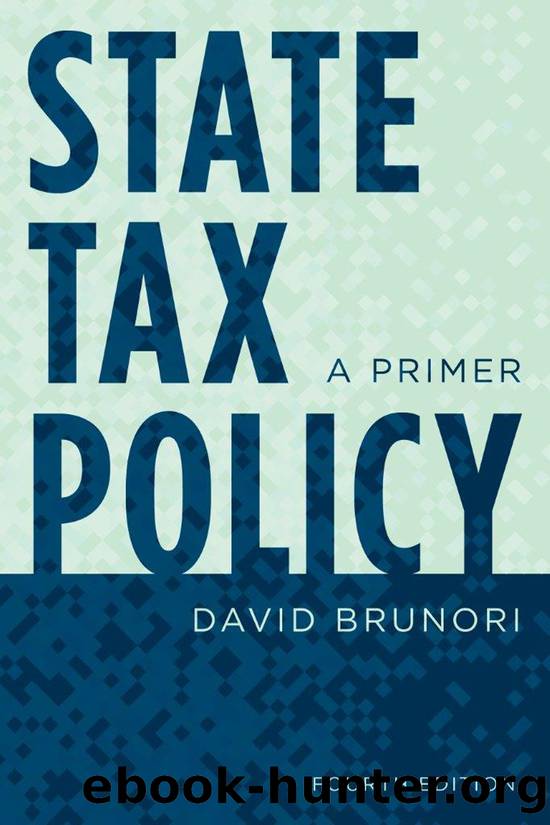State Tax Policy by Brunori David;

Author:Brunori, David;
Language: eng
Format: epub
Publisher: Rowman & Littlefield Publishers, Incorporated
Chapter 7
Corporate Income Taxes
Of the states, 44 tax corporate net income, including such traditionally anti-income tax jurisdictions as Tennessee, New Hampshire, and Florida. In 2013 the tax accounted for about $45 billion in tax revenue for the states, according to the U.S. Census Bureau.1 Only Nevada, Ohio, South Dakota, Texas, Washington, and Wyoming do not impose any taxes on corporate income.2
State corporate income and franchise taxes are among the most complicated and controversial components of state revenue systems. The application of the tax to interstate corporate business is one particularly complicated area. Formulary apportionment, distinctions between business and nonbusiness income, and a myriad of planning opportunities test tax practitioners at every filing. Attorneys and accountants struggle with laws designed to raise revenue, spur economic development, and comply with constitutional and federal statutory limitations on state taxing authority.
Controversies naturally arise when states attempt to get their most powerful economic institutions to pay for government services. Corporations have the means to influence tax policy more than almost any other interest group. Corporate interests often bring forceful policy argumentsâsome valid, some less soâfor minimizing business and corporate taxes.
Corporate income taxes make up a surprisingly small portion of state revenues. The relative importance of the state corporate income tax has steadily declined for decades. From its high of about 9.5 percent of total state tax revenue in 1977, the state corporate income tax dropped to about 5.3 percent in 2013. And the tax accounts for just 2 percent of total state revenue (tax and nontax revenue). The corporate income taxâs importance is dwarfed by the much larger amount of revenue collected from personal income, consumption, and excise taxes.
Nonetheless, inordinate resources and intellectual capital are used to administer and comply with state corporate income taxes. Tax commentators and scholars have long noted the difference in administrative and compliance costs for the corporate income tax relative to other levies (Brunori 2002c; Pomp 1998). The reason for this cost-benefit imbalance is that corporations generally have the resources to planâand when necessary, to disputeâtax matters. Specifically, corporations are able to employ highly trained and skilled lawyers, accountants, and economists. Maintaining this expertise also raises corporationsâ compliance costs.
The private sectorâs highly trained, well-paid attorneys and accountants also significantly raise the costs of administering the corporate income tax for states. To meet the companiesâ intellectual firepower, the states must hire, train, and retain equally qualified tax professionals. Although the state corporate income tax raises very little revenue compared with other levies, it devours a disproportionate amount of planning and litigation resources.
In many cases, the amount of time and resources devoted to the tax outweighs its financial contribution to the states. Even in states with long traditions of progressive taxation, which would seem most likely to rely on the tax, the revenue gained from corporate taxes is minimal. For example, Oregon, historically one of the most progressive states in terms of taxation, has no sales tax and a history of relatively high personal income taxes. Despite this progressive tradition, the state raised only 5 percent of its tax revenue from corporate levies in 2013.
Download
This site does not store any files on its server. We only index and link to content provided by other sites. Please contact the content providers to delete copyright contents if any and email us, we'll remove relevant links or contents immediately.
The Secret History by Donna Tartt(16677)
The Social Justice Warrior Handbook by Lisa De Pasquale(11495)
Thirteen Reasons Why by Jay Asher(7808)
This Is How You Lose Her by Junot Diaz(5804)
Weapons of Math Destruction by Cathy O'Neil(5056)
Zero to One by Peter Thiel(4841)
The Myth of the Strong Leader by Archie Brown(4796)
Promise Me, Dad by Joe Biden(4461)
Beartown by Fredrik Backman(4445)
How Democracies Die by Steven Levitsky & Daniel Ziblatt(4429)
Stone's Rules by Roger Stone(4426)
The Fire Next Time by James Baldwin(4356)
100 Deadly Skills by Clint Emerson(4093)
A Higher Loyalty: Truth, Lies, and Leadership by James Comey(4044)
Rise and Kill First by Ronen Bergman(4026)
The David Icke Guide to the Global Conspiracy (and how to end it) by David Icke(3900)
The Farm by Tom Rob Smith(3884)
Secrecy World by Jake Bernstein(3793)
The Doomsday Machine by Daniel Ellsberg(3743)
